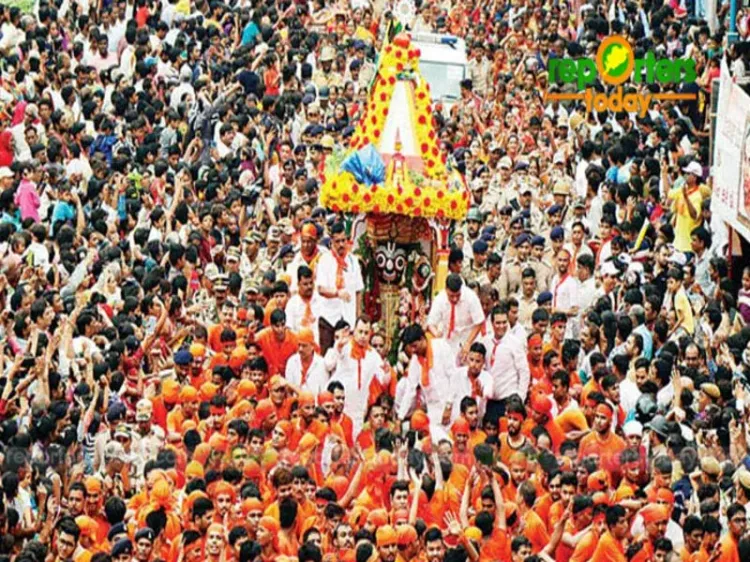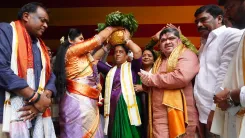What Makes Ahmedabad's 147-Year-Old Jagannath Rath Yatra Unique?

Synopsis
Key Takeaways
- Jagannath Rath Yatra is a historical celebration in Ahmedabad.
- The event attracts over 1 million devotees annually.
- Modern technology enhances safety and participation.
- The festival fosters community unity and inclusivity.
- It has evolved from modest beginnings to a grand spectacle.
Ahmedabad, June 26 (NationPress) The largest city in Gujarat, Ahmedabad, is gearing up for the 148th edition of the Rath Yatra of Lord Jagannath this Friday, marking one of the most anticipated spiritual and cultural celebrations. Steeped in centuries of tradition, the Rath Yatra, referred to as the ‘Chariot Festival’, transcends mere religious observance, representing the rich cultural heritage, social inclusivity, and civic cooperation of the state.
Notably, Ahmedabad’s Rath Yatra is the second largest in India, following the one in Puri, Odisha. The 19th century witnessed a revival of Vaishnavism in Gujarat, particularly through prominent sects like Pushtimarg and Swaminarayan Sampraday, which garnered significant urban support.
The Jagannath sect, deeply connected to the worship of Krishna, found a strong following among these urban Vaishnavas. Inspired by the grandeur of the Puri Rath Yatra during his pilgrimage, Mahant Narsinhdasji resolved to initiate a similar event in Ahmedabad.
The temple located in Jamalpur, believed to be nearly 450 years old, was chosen as the epicenter of this celebration. He envisioned a procession that would not only reflect the spiritual magnificence of Puri but also bring the divine closer to the community, especially to those unable to travel east.
Researchers note that during the British era, religious festivals emerged as platforms for cultural assertion and community identity. The Rath Yatra, characterized by massive public participation, vibrant celebrations, and inclusive engagement, became a prominent annual expression of Hindu presence in a progressively segmented urban landscape.
Interestingly, the early Rath Yatras of the late 1800s featured modest chariots and small processions, primarily within the confines of the walled city. However, by the early 20th century, the event had expanded significantly, drawing the attention of the British administration, which sometimes intervened under the guise of maintaining law and order.
The procession kicks off at around 7:00 a.m. from the historic Jagannath Temple in Jamalpur. It winds through key areas of the walled city including Kalupur, Prem Darwaja, Delhi Chakla, Shahpur, and Astodia, before returning to the temple by late evening, covering an impressive 16-kilometer route.
The deities, Lord Jagannath, Balabhadra, and Subhadra, are transported in chariots pulled by hundreds of devoted followers. The 'Pahind Vidhi', a ceremonial sweeping of the path, is traditionally performed by the Chief Minister of Gujarat, symbolizing humility and service. While deeply rooted in devotion, the event also exemplifies a successful collaboration among citizens, law enforcement, civic organizations, and faith communities.
In 2024, more than 1 million devotees attended, and a similar turnout is anticipated this year.
“For us, Rath Yatra is not just a festival, it’s an emotion. Watching the deities emerge from the temple feels like a personal blessing,” shared Meena Patel, a 52-year-old resident of Jamalpur.
The 2025 edition will introduce groundbreaking technological advancements, including AI-based crowd monitoring, 3D route mapping, and surveillance facilitated by 3,500 CCTV cameras, 2,872 body-worn cameras, 25 watchtowers, and 240 terrace points.
Over 23,884 security personnel will be deployed, and 484 dilapidated structures along the procession route have been secured for safety.
Moreover, the Rath Yatra has become a catalyst for social cohesion, with peace committee meetings, women-led outreach initiatives, and community sports and cultural events organized as part of pre-yatra activities.




